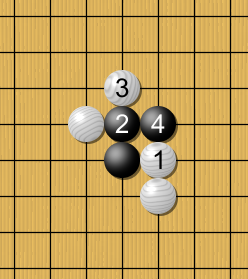I've been kind of busy recently with the EGF Academy. But I think the time making this post is worth it, as it will collectively save you, my readers, more time in your future games than it took me to make this.
Below I've collected some principles on capturing races.
1.) In the land of the blind, the one-eyed man is king.
Also known under the less poetic term "me ari me nashi" (have eye don't have eye). It means when someone has an eye vs. a group without eyes, the common liberties belong to the one-eyed group.
By playing the stupid-looking move at 1, Black clearly establishes an advantage in the capturing race of 5 vs. 4 liberties. (Even if White starts playing, White is dead.)
2.) 5, 8, 12, 17
Remember these numbers! A nakade (dead-shape) group with 4 spaces inside has 5 liberties. A nak... actually let me put it in a table:
4 spaces = 5 liberties
5 spaces = 8 liberties
6 spaces = 12 liberties
(7 spaces = 17 liberties, this one is rare and hard to illustrate)
1, 2 and 3 spaces don't have extra liberties other than the visible ones.
These numbers will help you read out semeais faster than ever. Let me explain further though:
Here Black has 8 liberties inside. White has 8 liberties outside.
Playing in the nakade shape counts as taking a liberty. So now Black has 7 liberties inside. White wins by 1 liberty. Feel free to read it out move-by-move if you don't believe me. Then check how much time you could have saved by believing me~
For the slightly more advanced: In a real game, when you count White's territory in this shape, do not forget to subtract 7 (semedori).
Let's look at an example from a real game of mine (I was Black):
White's liberties are a simple matter of counting. We can see that White also has 7 liberties, so Black wins by playing first, right?
That's what I thought during the game as well. But looking carefully, White's shape has 2 convoluted cannot-approach-double liberties, so actually White wins by one liberty. That was unfortunate for me.
Fortunately, after capturing Black's group, White's whole-board position is a disaster. Black has sente and controls the whole rest of the board. I also kept the position in the previous diagram (without playing out the semeai), as taking each liberty is an absolute ko-threat. So basically Black can do whatever he wants for the rest of the game, which is what happened. So I won the game after accidentally sacrificing the corner group.
Anyway... :)
3.) In the land of the one-eyed, the bigger-eyed is more king.
In a semeai between 2 groups with 1 eye each, the common liberties belong to the eye with more spaces=bigger eye space.
For White it's actually the same as not having an eye at all. This is the same semeai as in 2.) in spite of White's eye.
(1, 2 and 3 spaces count as the same size of eye.)
4.) Formula for semeai between 2 non-eyed groups
I omitted things like "when both have the same amount of liberties, the one who starts, wins", as I assume you are familiar with that concept. Sometimes, however, there are so many common liberties that you are not sure whether it's a seki or not. There exists a simple formula for that:
Given that: -neither group has an eye (or both groups have the same size of eye),
-it's your turn to play,
-you want to test if you can kill the opponent's group,
you win if
your outside liberties ≥ your opponent's outside liberties + common liberties - 1
Using this formula, we (Black) will try to kill above White's group:
7 ≥ 2 + 6 - 1
This is true, so Black wins by playing first. (If the difference is 1 or more, Black wins anyway.)
To demonstrate it better, White now has one more liberty. If Black tries to kill White:
7 ≥ 3 + 6 - 1
This is false, so Black cannot kill White.
Secondly, can White kill Black?
3 ≥ 7 + 6 - 1
This is obviously extremely false too, so White cannot kill Black either. Therefore the position is a seki.
5.) Semeai that includes ko
-take outside ko first
-take inside ko last
Please try these out by yourselves~








































